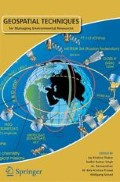Abstract
Extreme events in general, and the geomorphologic ones in particular, are highly topical problems. There were addresses by many researchers in the field of geology and physical geography (more specific by the climatologists and geomorphologists), but also by biologists, chemists, ecologists, etc. These are studied through the analysis of some types of processes and production mechanisms, and secondly by the effects they create on other environmental subsystems.
Access this chapter
Tax calculation will be finalised at checkout
Purchases are for personal use only
Preview
Unable to display preview. Download preview PDF.
References
Alcantara-Ayala, I. (2002). Geomorphology, natural hazards, vulnerability and prevention of natural disasters in developing countries. Geomorphology, 47, 107— 124, Amsterdam, Elsevier.
Alkema, D. and Cavallin, A. (2001). Geomorphologic Risk Assessment for EIA, Studi Trontini, di Scienze Natureli. Acta Geologica, 78, 139-145.
Cannon, T. (1993). A hazard need not a disaster make: vulnerability and the causes of natural disasters. In: Merriman, P.A., Browitt, C.W.A. (Eds.), Natural Disasters: Protecting Vulnerable Communities (pp. 92- 105). Thomas Telford, London.
Ciobanu, R. (2007). The implications of the geological support in the geographical risk phenomena: the Sibiu County case. Brukenthal. Acta Musei, Sibiu, II(3), 19-29.
Ciupangea, D., Pauca, M. and Ichim, Tr. (1970). Geologia Depresiunii Transilvaniei. Bucuresti, Editura Academiei.
Costea, M. (2006). Riscul la inundatii. Impactul in peisaj. In: Stef, V. and Costea, M. (Eds.), Hidrologie aplicata (pp. 205-240). Sibiu, Editura Universitatii "Lucian Blaga".
Giusca, R. (2006). Modele ale degradarilor de teren din Muntii Sureanu, Muntii Cindrel si Depresiunea Sibiului. Sibiu, Editura Universitatii "Lucian Blaga".
Ielenicz, M. (2004). Geomorfologie, Editura Universitatii, Bucuresti.
Matthes-Sears, U., Matthes-Sears, W.C., Hastings, J.C. and Oechel, W.C. (1988). The effects of topography and nutrient status on the biomass, vegetative characteristics, and gas exchange of two deciduous shrubs on an arctic tundra slope. Arctic and Alpine Research, 20, 342-351.
Murray, C. and Miller, P.C. (1982). Phenological observations of major plant growth forms and species in montane and Eriophorum vaginatum tussock tundra in central Alaska. Holarctic Ecology, 5, 109-116.
Neaupane, K.M. and Piantanakulchai, M. (2006). Analytic network process model for landslide hazard zonation. Engeneering Geology, 85, 281-294.
Nellemand, C. and Fry, G. (1995). Quantitative Analysis of Terrain Ruggedness in Reindeer Winter Grounds. Arctic, 48(2), 172-176.
Panizza, M. (1986). The geomorphological hazard assessment and the analysis of geomorphological risk. In: V. Gardiner (ed.). InternationalGeomorphology. Wiley, Chichester, 225-229.
Panizza, M. (1996). Environmental Geomorphology in Developments. Earth Surface Processes 4, Elsevier, Amsterdam.
Posea, Gr. (2002). Geomorfologia Romaniei. Bucuresti, Editura Fundatiei "Romania de Maine".
Sandu, M. (1998). Culoarul depresionar Sibiu - Apold. Studiu geomorfologic. Bucuresti, Editura Academiei.
Soeters, R. and van Westen, C.J. (1996). Slope instability recognition, analysis and zonation. In: Turner, A.K. and Schuster, R.L. (Eds.), Landslides. Investigation, Mitigation, Transportation Research Board (pp. 129-177). Special Report 247, National Academy Press, Washington D.C.
Thakur, J.K., Srivastava, P.K., Singh, S.K. and Vekerdy, Z. (2011). Ecological monitoring of wetlands in semi-arid region of Konya closed basin, Turkey. Regional Environmental Change (DOI: 10.1007/s10113-011-0241-x).
Toderas, T. and Giusca, R. (2004). Aplicarea noilor tehnici GIS in evaluarea reliefului din Depresiunea Sibiului. Revista Geografica, Bucuresti, 68-72.
Tufescu, V. (1966). Subcarpatii si Depresiunile marginale ale Transilvaniei, Bucuresti, Editura Stiintifica.
Varnes, D.J. (1984). Landslide hazard zonation: A review of principles and practice. United Nations International, Paris.
Wilson, M.F.J. et al. (2007). Multiscale terrain analysis of multibeam bathymetry data for habitat mapping on the continental slope. Marine Geodesy, 30, 3-35.
Zezere, J.L. (2002). Landslide susceptibility assessment considering landslide typology. A case study in the north Lisbon (Portugal). Natural Hazards and Earth System Sciences, EGU. 2, 73-82.
Author information
Authors and Affiliations
Editor information
Editors and Affiliations
Rights and permissions
Copyright information
© 2011 Capital Publishing Company
About this chapter
Cite this chapter
Costea, M., Giusca, R., Ciobanu, R. (2011). Geomorphologic Risk Modelling of the Sibiu Depression Using Geospatial Surface Analyses. In: Thakur, J.K., Singh, S.K., Ramanathan, A., Prasad, M.B.K., Gossel, W. (eds) Geospatial Techniques for Managing Environmental Resources. Springer, Dordrecht. https://doi.org/10.1007/978-94-007-1858-6_8
Download citation
DOI: https://doi.org/10.1007/978-94-007-1858-6_8
Publisher Name: Springer, Dordrecht
Print ISBN: 978-94-007-1857-9
Online ISBN: 978-94-007-1858-6
eBook Packages: Earth and Environmental ScienceEarth and Environmental Science (R0)

